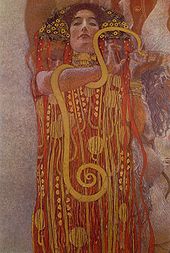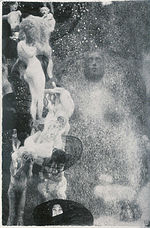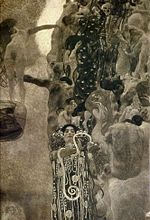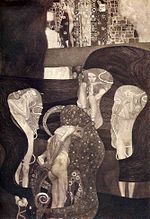- Klimt University of Vienna Ceiling Paintings
-
 The bottom portion of the Medicine, showing Hygieia
The bottom portion of the Medicine, showing Hygieia
The Klimt University of Vienna Ceiling Paintings, also known as the Faculty Paintings, were a series of paintings made by Gustav Klimt for the ceiling of the University of Vienna's Great Hall between the years of 1900-1907. In 1894, Klimt was commissioned to paint the ceiling. Upon presenting his paintings, Philosophy, Medicine and Jurisprudence, Klimt came under attack for 'pornography' and 'perverted excess' in the paintings. None of the paintings would go on display in the university. In May 1945 all three paintings were destroyed by retreating SS forces.
Contents
Philosophy
 Philosophy, 1899–1907. Ceiling panel for the Great Hall of Vienna University. Destroyed by fire in Schloss Immendorf in 1945.[1]
Philosophy, 1899–1907. Ceiling panel for the Great Hall of Vienna University. Destroyed by fire in Schloss Immendorf in 1945.[1]
Philosophy [2][dead link] was the first of the three pictures presented to the Austrian Government at the seventh Vienna Secession exhibition in March 1900. It had been awarded a gold medal at the World Exhibition in Paris, but was attacked by those in his own country. Klimt described the painting as follows: "On the left a group of figures, the beginning of life, fruition, decay. On the right, the globe as mystery. Emerging below, a figure of light: knowledge." Critics were disturbed by its depiction of men and women drifting in an aimless trance. The original proposal for the theme of the painting was "The Victory of Light over Darkness", but what Klimt presented instead was a dreamlike mass of humanity, referring neither to optimism nor rationalism, but to a "viscous void".[3] A rough study of the painting can be found here.[4]
Medicine
Medicine [5] was the second painting, presented in March 1901 at the tenth Secession Exhibition. It featured a column of nude figures on the right hand side of the painting, representing the river of life. Beside it was a young nude female who floated in space, with a newborn infant at her feet, representing life. A skeleton represented death in the river of life . The only link between the floating woman and the river of bodies is two arms, the woman's and a man's as seen from behind. At the bottom of the painting Hygieia stood with the Aesculapian snake around her arm and the cup of Lethe in her hand, turning her back to mankind. Klimt conveyed an ambiguous unity of life and death, with nothing to celebrate the role of medicine or the science of healing.[6] Upon display of the painting in 1901, he was attacked by critics who could have noted that Vienna was leading the world in medical research under such figures as Theodor Billroth (1829-94), Frantisek Chvostek (1835-84), and Ludwig Türck (1810-68). An editorial in the Medizinische Wochenschrift complained that the painter had ignored doctors' two main achievements, prevention and cure. For a rough composition draft of the painting see here.[7]
Jurisprudence
Jurisprudence [8][dead link]was the third of the paintings presented at the eighteenth Secession Exhibition in November 1903. As in the other murals, the central theme is man's conflicted existence.[9] It, too, is laden with anxiety: A condemned man is depicted surrounded by the three female furies: Truth, Justice and Law. They are shown as the Eumenides, punishing the condemned man with an octopus's deadly embrace. It is not surprising that the conflict in Jurisprudence has been seen as "psycho-sexual".[10]
Reaction
The paintings were attacked by critics when they were presented, as each painting broke different cultural taboos, contradicting the trend of the era to 'sublimate reality and to only present its more favourable aspects.'(Neret) The paintings also drew the standard charges of obscenity which Klimt often faced. Eighty-seven faculty members protested against the murals,[11] and in 1901 a public prosecutor was called in and the issue even reached the Parliament of Austria, the first time that a cultural debate had ever been raised there, but in the end no action was taken. Only the education minister defended Klimt, and when Klimt was elected to be a professor at the Academy of Fine Arts in 1901 the government refused to ratify the action. He was never offered another teaching position. This would also be the last time Klimt would accept commissions from the state, remarking: "I've had enough of censorship...I reject all state support, I don't want any of it."[12]
A later painting of his entitled Goldfish (to my critics) (1901-1902) [13] which showed a smiling, beautiful woman projecting her bottom at the viewer, an obvious response to all those who attacked the 'pornography' and perverted excess' of the University paintings.
Outcome and destruction
The paintings were requested for an exhibition in St Louis in 1904, but the ministry declined, nervous of what the reaction might be. Klimt then resigned his commission, wishing to keep his work, but the ministry insisted they were already property of the state. Only when Klimt threatened the removal staff with a shotgun was he able to keep his painting. Klimt repaid his advance of 30,000 crowns with the support of August Lederer, one of his major patrons, who in return received Philosophy. In 1911 Medicine and Jurisprudence were bought by Klimt's friend and fellow artist, Koloman Moser. Medicine eventually came into the possession of a Jewish family, and in 1938 the painting was seized by Germany. In 1943, after a final exhibition, they were moved to Schloss Immendorf, a castle in Lower Austria, for protection. In May 1945 the paintings were destroyed as retreating German SS forces set fire to the castle to prevent it falling into enemy hands. All that remains now are preparatory sketches and a few photographs, most notably that of one focusing solely on Hygieia. Only one photograph remains of the complete painting of Medicine, taken just before it was destroyed. [5]
Notes
- ^ Gilles Néret (1999). Gustav Klimt: 1862-1918. Taschen. p. 94. ISBN 9783822859803.
- ^ "University of Wales Trinity Saint David". Lamp.ac.uk. http://www.lamp.ac.uk/philosophy/phil.jpg. Retrieved 2010-12-15.
- ^ Fleidl, Gottfried: "Gustav Klimt 1862-1918 The World in Female Form", p. 77, Benedikt Taschen, 1994.
- ^ http://cgfa.sunsite.dk/klimt/klimt15.jpg
- ^ a b "PubMed Central, Figure: BMJ. 2002 December 21; 325(7378): 1506–1508". Pubmedcentral.nih.gov. 2010-11-16. http://www.pubmedcentral.nih.gov/articlerender.fcgi?artid=139056&rendertype=figure&id=FN0x97627f0.0x9a779b8. Retrieved 2010-12-15.
- ^ Fliedl, p. 81, 1994.
- ^ http://www.artchive.com/artchive/k/klimt/klimt_medicine.jpg
- ^ [1][dead link]
- ^ Fleidl, p. 86, 1994.
- ^ Fleidl, p. 86, 1994.
- ^ Fleidl, p. 81, 1994.
- ^ Fleidl, p. 88, 1994.
- ^ http://static.flickr.com/62/184668037_1422f16c45.jpg
References
- http://www.pubmedcentral.nih.gov/articlerender.fcgi?artid=139056#B2
- http://www.kilidavid.com/Art/Pages/Artists/klimt.htm
- Gilles Neret. "Klimt". Taschen, 1993. ISBN 978-3-8228-5980-3
External links
Categories:- Gustav Klimt paintings
- Lost paintings
- University of Vienna
Wikimedia Foundation. 2010.


